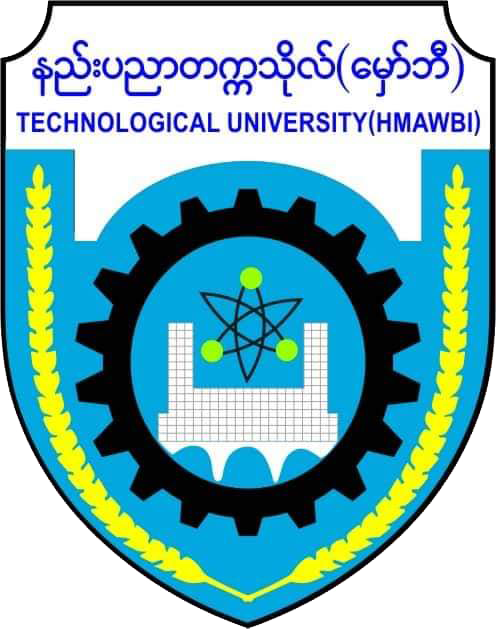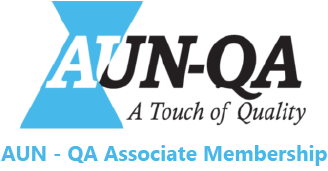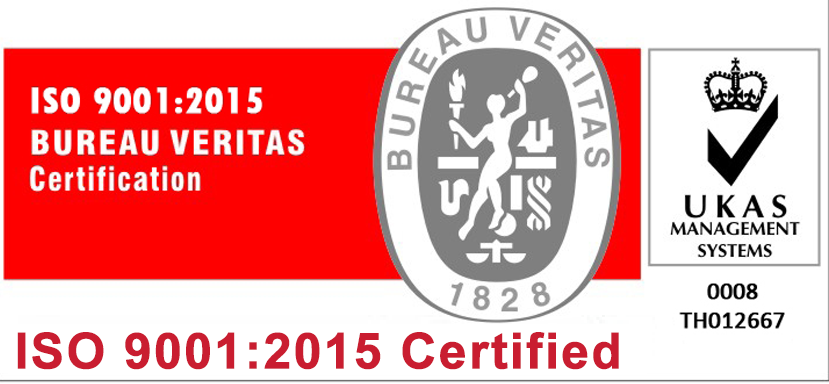
Technological University (Hmawbi)





Department of Electronic Engineering offers undergraduate programs that emphasize the fundamentals of electronic engineering and enable graduates to enter the workforce with confidence. Undergraduate curricula are offered that lead to Bachelor of Engineering degrees in electronic engineering (BE). Advanced studies leading to the Master of Engineering (ME) in Electronic Engineering are available. The Electronic Engineering department provides teaching and research activities mainly in the areas of
| No | Code | Course Title | Period Per Week | Credit Point | |||
|---|---|---|---|---|---|---|---|
| Lect. | Tut. | Pract. | Total | ||||
| 1 | EcE-11011 | Fundamental of Electronic Circuits I | 2 | 0 | 1 | 3 | 2.5 |
| 2 | EcE-12011 | Fundamental of Electronic Circuits II | 2 | 0 | 1 | 3 | 2.5 |
| 3 | M 11001 | Myanmar | 2 | 0 | 0 | 2 | 1.5 |
| 4 | E 11011 | English | 2 | 1 | 0 | 3 | 2.5 |
| 5 | EM 11001 | Engineering Mathematics I | 4 | 1 | 0 | 5 | 4.5 |
| 6 | E.Ch 11011 | Engineering Chemistry I | 3 | 1 | 2 | 6 | 4.5 |
| 7 | E.Ph 11011 | Engineering Physics I | 2 | 1 | 2 | 5 | 3.8 |
| 8 | ME 11011 | Basic Engineering Drawing I | 1 | 0 | 2 | 3 | 2 |
| 9 | M 12011 | Myanmar II | 2 | 0 | 2 | 4 | 2 |
| 10 | E 12011 | English | 2 | 1 | 0 | 3 | 2.5 |
| 11 | EM 12002 | Engineering Mathematics II | 4 | 1 | 0 | 5 | 4.5 |
| 12 | E.Ch 12011 | Engineering Chemistry II | 3 | 1 | 2 | 6 | 4.5 |
| 13 | E.Ph 12011 | Engineering Physics II | 2 | 1 | 2 | 5 | 3.5 |
| 14 | ME 12011 | Basic Engineering Drawing II | 1 | 0 | 2 | 3 | 2 |
M 11011 Myanmar (2-0-0)
See under Department of Myanmar.
Blueprint B1 - Intermediate Student Book
1.Functions
2.Limits and Continuity
3.Differentiation
4.Applications of Derivatives
5.Integration
REFERENCE
[1] George B.Thomas, M. D. Weir, J. R. Hass, Thomas’ Calculus: Early Transcendentals,
Twelfth Edition, Addison-Wesley, 2006.
Chapter 1 Atomic and Molecular Structure (12 Hrs)
Atomic Structure; Distribution of Electrons in Different Energy Levels; Valence Shell and Valence Electrons; Isotopes; Isobars; Nature of Light and Electromagnetic Waves; Wave Nature of Light; Electromagnetic Spectrum; Quantum Nature of Light; Photoelectric Effect; Bohr’s Theory of Atomic Structure; Drawbacks of Bohr Model; Quantum Mechanical Model of the Atom; Dual Nature of Electron (Wave Nature and Particles); Heisenberg’s Uncertainty Principle; Orbitals and Quantum Numbers; Quantum Number; Principle Quantum Number; Azimuthal Quantum Number; Magnetic Quantum Number; Spin Quantum Number; Pauli’s Exclusion Principle; Electronic Configuration of Atoms; Aufbau Principle; Hund’s Rule of Maximum Multiplicity; Writing Lewis Structures; Formal Charge; The Structure of Molecules; Some Terminology; Valence Shell Electron-Pair Repulsion (VSEPR ) Theory; Possibility for Electron Pair Distribution; Applying VSEPR Theory; Structures with Multiple Covalent Bonds; Molecular Shapes and Dipole moments.
Chapter 2 Principle of Chemical Equilibrium (8 Hrs)
Dynamic Equilibrium; The Equilibrium Constant Expression; Relationships involving Equilibrium constants; Relationship of Kc to the Balanced Chemical Equation; Combining Equilibrium Constant Expression; Equilibria involving Gases: The Equilibrium Constant, Kp; Equilibria involving Liquids and Solids; The Reaction Quotient, Q; Predicting the Direction of a Net Reaction; Altering Equilibrium Conditions; Lechatelier’s Principle; Effect of Changes the Amounts of Reacting Species on Equilibrium; Effect of Changes in Pressure or Volume on Equilibrium; Effect of Temperature on Equilibrium; Effect of a Catalyst on Equilibrium; Equilibrium Calculation: Some Ilustrative Examples.
Chapter 3 Chemistry of Engineering Materials (10 Hrs)
Refractories: Characteristics of a good Refractory; Classification of Refractories; Manufacture of Refractories; Properties of Refractories; Important Refractories.
Abrasives: Abrasive Power; Properties of Abrasives; Classification of Abrasives; Uses of Abrasives.
Adhesives: Requirements of a Good Adhesive; Advantages of Adhesive Bonding; Disadvantages of Limitations of Adhesive Bonding; Development of Adhesive Strength; Classification of Adhesives.
Lubricants: Functions of a Lubricant; Classification of Lubricants, Characteristics of Good Lubricants.
Ceramics: Basic Raw Materials for Ceramics; General Properties of Ceramics; Manufacturing Process; Cement; Gypsum.
Composites: Composites Material Structure; Types of Composites, Applications of Composites Materials.
Chapter 4 Metals and Their Applications (10 Hrs)
Metallurgy ( Extracting a Metal from its Ore) - Common Ores, Isolation of Metals from its Ores; Zinc – Production of Zinc from Zinc Blend, Uses (Zn); Iron and Steel – Uses (Iron and Steel); Copper- Isolation and Electro Refining of Copper, Uses (Cu); Aluminium – Production of Aluminium, Properties and Uses of Aluminium; Silver – Properties and Uses of Silver.
| This course provides a conceptually-based exposure to the fundamental principles and process of the physical world. Topics include basic concepts of motion, forces, energy, fluid mechanics, oscillations and mechanical waves and thermodynamics. Laboratory experiments enhance and consolidate the understanding of basic physical principles and applications. |
ME 11011 Basic Engineering Drawing (1-0-2) (2 Credit Points)
Introduction, Drawing Equipment and Lettering, Line types, dimensioning, Geometric Constructions, Orthographic Drawing, Free-hand Sketching, Missing Views, Sectional Views
1. Complex Numbers
2. Linear Algebra I
3. Techniques of Integration
4. Conic Section
5. Probability Theory & Mathematical Induction
REFERENCES
[1] George B.Thomas , Maurice D.Weir, Joel R.Hass, Calculus & Analytic Geometry,
Seventh Edition.
[2] George B.Thomas, M. D. Weir, J. R. Hass, Thomas’ Calculus: Early Transcendentals,
Twelfth Edition, Addison-Wesley, 2006.
[3] Vance, Modern Algebra and Tigonometry, Third Edition, John Wieley & Sons Inc.,
1963.
[4] Erwin Kreyszig, H. Kreyszig, E.J. Norminton, Advanced Engineering Mathematics,
10th Edition, John Wieley & Sons Inc., 2011.
| This course provides a conceptually-based exposure to the fundamental principles and process of the physical world. Topics include basic concepts of electricity, magnetism, light & optics, Quantum Mechanics and Nuclear Physics. Laboratory experiments enhance and consolidate the understanding of basic physical principles and applications. |
ME 12011 Basic Engineering Drawing (1-0-2) (2 Credit Points)
Auxiliary Views, Basic Descriptive Geometry, Basic Object Development, Intersection of Solids, Pictorial Drawing: Isometric Projection.
| No | Code | Course Title | Period Per Week | Credit Point | |||
|---|---|---|---|---|---|---|---|
| Lect. | Tut. | Pract. | Total | ||||
| 1 | E 11011 | English | 2 | 1 | 0 | 3 | 2.5 |
| 2 | EcE-21002 | Communication Principles I | 2 | 0 | 1 | 3 | 2.5 |
| 3 | EcE-21001 | Electronic Engineering Circuit I | 2 | 0 | 2 | 4 | 3 |
| 4 | EcE-21021 | Digital Electronics I | 2 | 0 | 1 | 3 | 2.5 |
| 5 | EcE-21011 | Microelectronics I | 2 | 1 | 1 | 4 | 3 |
| 6 | EcE-21014 | Technical Programming I | 2 | 0 | 2 | 4 | 3 |
| 7 | EM 21003 | Engineering Mathematics III | 4 | 1 | 0 | 5 | 4.5 |
| 8 | E 22011 | English | 2 | 1 | 0 | 3 | 2.3 |
| 9 | EM 22004 | Engineering Mathematics IV | 4 | 1 | 0 | 5 | 4.5 |
| 10 | EcE-22002 | Communication Principles II | 2 | 0 | 1 | 3 | 2.5 |
| 11 | EcE-22001 | Electronic Engineering Circuit II | 2 | 0 | 2 | 4 | 3 |
| 12 | EcE-22021 | Digital Electronics II | 2 | 0 | 1 | 3 | 2.5 |
| 13 | EcE-22011 | Microelectronics II | 2 | 1 | 1 | 4 | 3 |
| 14 | EcE-22014 | Technical Programming II | 2 | 0 | 2 | 4 | 3 |
Blueprint B1 - Intermediate Student Book
1. Application of Definite Integrals
2. Integrals and Transcendental Functions
3. Parametric Equations and Polar Coordinates
4. Vector and the Geometry of Space
5. Linear Algebra II
REFERENCES
[1] George B.Thomas, M. D. Weir, J. R. Hass, Thomas’ Calculus: Early Transcendentals,
Twelfth Edition, Addison-Wesley, 2006.
[2] Erwin Kreyszig, H. Kreyszig, E.J. Norminton, Advanced Engineering Mathematics,
10th Edition, John Wieley & Sons Inc., 2011.
1. Vector-Valued Functions and Motion in Space
2. Partial Derivatives
3. Multiple Integrals
4. Integration in Vector Fields
5. 1st Order ODEs
REFERENCES
[1] George B.Thomas, M. D. Weir, J. R. Hass, Thomas’ Calculus: Early Transcendentals,
Twelfth Edition, Addison-Wesley, 2006.
[2] Erwin Kreyszig, H. Kreyszig, E.J. Norminton, Advanced Engineering Mathematics,
10th Edition, John Wieley & Sons Inc., 2011.
| No | Code | Course Title | Period Per Week | Credit Point | |||
|---|---|---|---|---|---|---|---|
| Lect. | Tut. | Pract. | Total | ||||
| 1 | EcE-31002 | Digital Communication I | 2 | 2 | 0 | 4 | 3 |
| 2 | EcE-31011 | Engineering Electromagnetic I | 2 | 1 | 0 | 3 | 2.5 |
| 3 | EcE-31021 | Integrated Electronics I | 2 | 1 | 1 | 4 | 3 |
| 4 | EcE-31003 | Modeling and Control I | 2 | 1 | 1 | 4 | 3 |
| 5 | E 31011 | English | 2 | 1 | 0 | 3 | 2.5 |
| 6 | EM 31005 | Engineering Mathematics V | 4 | 1 | 0 | 5 | 4.5 |
| 7 | E 32011 | English | 2 | 1 | 0 | 3 | 2.5 |
| 8 | EM 32006 | Engineering Mathematics VI | 4 | 1 | 0 | 5 | 4.5 |
| 9 | EcE-32002 | Digital Communication II | 2 | 2 | 0 | 4 | 3 |
| 10 | EcE-32011 | Engineering Electromagnetic II | 2 | 1 | 0 | 3 | 2.5 |
| 11 | EcE-32021 | Integrated Electronics II | 2 | 1 | 1 | 4 | 3 |
| 12 | EcE-32003 | Modeling and Control II | 2 | 1 | 1 | 4 | 3 |
| 13 | EcE-31001 | Engineering Circuit Analysis I | 2 | 1 | 2 | 5 | 3.5 |
| 14 | EcE-32001 | Engineering Circuit Analysis II | 2 | 1 | 2 | 5 | 3.5 |
Blueprint B2 - Pre-Advanced
1.Infinite Sequences and Series
2.2nd Order Linear ODEs
3.Higher Order Linear ODEs
4.Laplace Transforms
5.Fourier Analysis
REFERENCES
[1] George B.Thomas, M. D. Weir, J. R. Hass, Thomas’ Calculus: Early Transcendentals,
Twelfth Edition, Addison-Wesley, 2006.
[2] Erwin Kreyszig, H. Kreyszig, E.J. Norminton, Advanced Engineering Mathematics,
10th Edition, John Wieley & Sons Inc., 2011.
1.Complex Numbers and Functions. Complex Differentiation
2.Complex Integration
3.Power Series, Taylor Series
4.Laurent Series. Residue Integration
5.Conformal mapping
REFERENCE
[1] Erwin Kreyszig, H. Kreyszig, E.J. Norminton, Advanced Engineering Mathematics,
10th Edition, John Wieley & Sons Inc., 2011.
| No | Code | Course Title | Period Per Week | Credit Point | |||
|---|---|---|---|---|---|---|---|
| Lect. | Tut. | Pract. | Total | ||||
| 1 | EcE-41002 | Computer Communication I | 2 | 1 | 1 | 4 | 3 |
| 2 | EcE-41021 | Digital Design with HDL I | 2 | 1 | 1 | 4 | 3 |
| 3 | EP-41043 | Electrical Machines I | 2 | 1 | 0 | 3 | 3 |
| 4 | EcE-41031 | Industrial Electronic & Control I | 2 | 1 | 1 | 4 | 3 |
| 5 | E 41011 | English | 2 | 1 | 0 | 3 | 2.3 |
| 6 | EM 41007 | Engineering Mathematics VII | 4 | 1 | 0 | 5 | 4.5 |
| 7 | EcE-41003 | Modern Control System I | 2 | 1 | 1 | 4 | 3 |
| 8 | E 42011 | English | 2 | 1 | 0 | 3 | 2.3 |
| 9 | EM 42008 | Engineering Mathematics VIII | 4 | 1 | 0 | 5 | 4.5 |
| 10 | EcE-42002 | Computer Communication II | 2 | 1 | 1 | 4 | 3 |
| 11 | EcE-42021 | Digital Design with HDL II | 2 | 1 | 1 | 4 | 3 |
| 12 | EcE-42003 | Modern Control System II | 2 | 1 | 1 | 4 | 3 |
| 13 | EP-42043 | Electrical Machines II | 2 | 1 | 0 | 3 | 3 |
| 14 | EcE-42031 | Industrial Electronic & Control II | 2 | 1 | 1 | 4 | 3 |
Blueprint C1 - Advanced
1. Numerics in General
2. Numeric Linear Algebra
3. Numerics for ODEs
4. Unconstrained Optimization. Linear Programming
REFERENCE
[1] Erwin Kreyszig, H. Kreyszig, E.J. Norminton, Advanced Engineering Mathematics,
10th Edition, John Wieley & Sons Inc., 2011.
1. Graphs. Combinatorial Optimization
2. Data Analysis Probability Theory/ Queueing Theory
3.Confidence Intervals
REFERENCES
[1] Erwin Kreyszig, H. Kreyszig, E.J. Norminton, Advanced Engineering Mathematics,
10th Edition, John Wieley & Sons Inc., 2011.
[2] J. K. Sharama, Operations Research: Theory and Applications, Macmillan Inc., 2000.
| No | Code | Course Title | Period Per Week | Credit Point | |||
|---|---|---|---|---|---|---|---|
| Lect. | Tut. | Pract. | Total | ||||
| 1 | EcE-51001 | Advanced Electronics I | 2 | 1 | 2 | 5 | 3.5 |
| 2 | EcE-51033 | PLC Programming Methods and Techniques | 2 | 0 | 3 | 5 | 3.5 |
| 3 | EcE-51003 | Digital Control System | 2 | 1 | 2 | 5 | 3.5 |
| 4 | EcE-51013 | Microwave Engineering | 2 | 1 | 1 | 4 | 3 |
| 5 | EcE-51012 | Modern Electronic Communication Systems I | 2 | 1 | 0 | 3 | 2.5 |
| 6 | EcE-51006 | Industrial Management I | 2 | 2 | 0 | 4 | 3 |
| 7 | EcE-51005 | Digital Signal Processing | 2 | 0 | 2 | 4 | 3 |
| 8 | EcE-52033 | PLC Programming Methods and Techniques II | 2 | 0 | 3 | 5 | 3.5 |
| 9 | EcE-52003 | Digital Control System II | 2 | 1 | 2 | 5 | 3.5 |
| 10 | EcE-52005 | Digital Signal Processing II | 2 | 0 | 2 | 4 | 3 |
| 11 | EcE-52013 | Microwave Engineering II | 2 | 1 | 1 | 4 | 3 |
| 12 | EcE-52012 | Modern Electronic Communication Systems II | 2 | 1 | 0 | 3 | 2.5 |
| 13 | EcE-52006 | Industrial Management II | 2 | 2 | 0 | 4 | 3 |
| 14 | EcE-52001 | Advanced Electronics II | 2 | 1 | 2 | 5 | 3.5 |
| No | Code | Course Title | Period Per Week | Credit Point | |||
|---|---|---|---|---|---|---|---|
| Lect. | Tut. | Pract. | Total | ||||
| 1 | HSS 61011 | Humanities and Social Science | 4 | 0 | 0 | 4 | 4 |
| 2 | EcE-61015 | Computer Networking | 2 | 0 | 2 | 4 | 3 |
| 3 | - | FYP (Final Year Project /Graduation Thesis / Mini Thesis ) and Internship | 0 | ||||
In second semester, final year students have to give at least three seminar presentations and viva voce, and thesis book for the FYP (Final Year Project /Graduation Thesis / Mini Thesis ) and Internship report, Log book and personal assessment for Internship Program.
Take Credit Points = 9 for FYP/ Graduation Thesis / Mini Thesis
Take Credit Points = 4 for Internship Program (Must be Continuous 4 Weeks)
(1 Lecture = 1 credit, 1 tutorial = 0.5 credit and 1 practical = 0.5 credit)